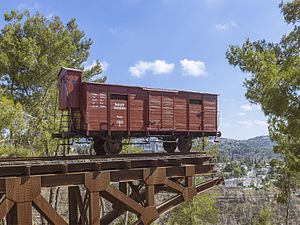Holocaust trains
| The Holocaust trains | |
|---|---|
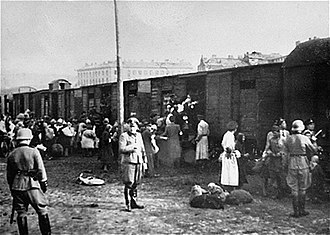 Polish Jews being loaded onto trains at Umschlagplatz of the Warsaw Ghetto, 1942. The site is preserved today as a Polish national monument. | |
| Operation | |
| Period | 1941–1944 |
| Location | Nazi Germany, German-occupied Europe, Axis countries in Europe |
| Prisoner victims | |
| Destination | Transit ghettos, Nazi concentration camps, forced labour and extermination camps |
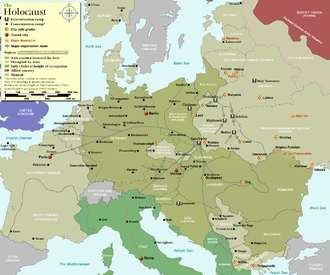
Holocaust trains were railway transports run by the Deutsche Reichsbahn and other European railways under the control of Nazi Germany and its allies, for the purpose of forcible deportation of the Jews, as well as other victims of the Holocaust, to the Nazi concentration, forced labour, and extermination camps.[1][2]
The speed at which people targeted in the "Final Solution" could be exterminated was dependent on two factors: the capacity of the death camps to gas the victims and quickly dispose of their bodies, as well as the capacity of the railways to transport the victims from Nazi ghettos to extermination camps. The most modern accurate numbers on the scale of the "Final Solution" still rely partly on shipping records of the German railways.[3][4]
Pre-war
The first mass deportation of Jews from Nazi Germany, the Polenaktion, occurred in October 1938. It was the forcible eviction of German Jews with Polish citizenship fuelled by the Kristallnacht. Approximately 30,000 Jews were rounded up and sent via rail to refugee camps.[5]
The role of railways in the Final Solution

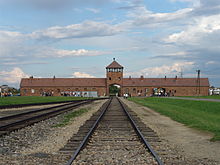
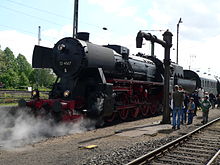
Within various phases of the Holocaust, the trains were employed differently. At first, they were used to concentrate the Jewish populations in the ghettos, and often to transport them to forced labour and German concentration camps for the purpose of economic exploitation.[9][10] In 1939, for logistical reasons, the Jewish communities in settlements without railway lines in occupied Poland were dissolved.[11] By the end of 1941, about 3.5 million Polish Jews had been segregated and ghettoised by the SS in a massive deportation action involving the use of freight trains.[12] Permanent ghettos had direct railway connections because the food aid (paid for by Jews themselves) was completely dependent on the SS, similar to all newly built labour camps.[13] Jews were legally banned from baking bread.[14] They were sealed off from the general public in hundreds of virtual prison-islands called Jüdische Wohnbezirke or Wohngebiete der Juden. However, the new system was unsustainable. By the end of 1941, most ghettoised Jews had no savings left to pay the SS for further bulk food deliveries.[13] The quagmire was resolved at the Wannsee conference of 20 January 1942 near Berlin, where the "Final Solution of the Jewish question" (die Endlösung der Judenfrage) was set in place.[15] It was a euphemism referring to the Nazi plan for the annihilation of the Jewish people.[16]
During the liquidation of the ghettos starting in 1942, the trains were used to transport the condemned populations to death camps. To implement the "Final Solution", the Nazis made the Deutsche Reichsbahn an indispensable element of the mass extermination machine, wrote historian Raul Hilberg.[10]
The Nazis disguised their "Final Solution" as the mass "resettlement to the east". The victims were told they were being taken to labour camps in Reichskommissariat Ukraine. In reality, from 1942 on, for most Jews, deportations meant being murdered at either Bełżec, Chełmno, Sobibór, Majdanek, Treblinka, or Auschwitz-Birkenau.[17] The plan was being realized in the utmost secrecy. In late 1942, during a telephone conversation, Hitler's private secretary Martin Bormann admonished Heinrich Himmler, who was informing him about 50,000 Jews already exterminated in a concentration camp in Poland. "They were not exterminated – Bormann screamed – only evacuated, evacuated, evacuated!", and slammed down the phone, wrote Enghelberg.[18]
Following the Wannsee Conference of 1942, the Nazis began to murder Jews in large numbers at death camps, newly built as part of Operation Reinhard. Since 1941, the Einsatzgruppen, mobile extermination squads, were already conducting mass shootings of Jews in Eastern Europe.[19] The Jews of Western Europe were either deported to ghettos emptied through mass killings, such as the Rumbula massacre of the inhabitants of the Riga Ghetto, or sent directly to Treblinka, Belzec, and Sobibór, extermination camps built in spring and summer of 1942 only for gassing. Auschwitz II Birkenau gas chambers began operating in March. The last death camp, Majdanek, began operating gas chambers in late 1942.[20][better source needed]
At Wannsee, the SS estimated that the "Final Solution" could ultimately eradicate up to 11 million European Jews; Nazi planners envisioned the inclusion of Jews living in neutral and non-occupied countries such as Ireland, Sweden, Turkey, and the United Kingdom. Deportations on this scale required the coordination of numerous German government ministries and state organisations, including the Reich Security Main Office (RSHA), the Reich Transport Ministry, and the Reich Foreign Office. The RSHA coordinated and directed the deportations; the Transport Ministry organized train schedules; and the Foreign Office negotiated with German-allied states and their railways about "processing" their own Jews.[21]
The deportation trains did not make major demands on the railways' resources; a typical day during the 1941-2 period would see 30,000 rail services operated by the Reichsbahn - of these, just two would be deportation trains. They were also a low priority, and SS officials such as Franz Novak often faced difficulty in securing the rolling stock needed.[22]
The journey and point of arrival
The first trains with German Jews expelled to ghettos in occupied Poland began departing from central Germany on 16 October 1941.[23] Called Sonderzüge (special trains),[24] the trains had low priority for the movement and frequently had to wait for other trains to pass, inevitably extending transport time beyond expectations.[24]
In Western and Central Europe, trains usually consisted of third class passenger carriages,[25] but in Eastern Europe they usually used freight wagons or cattle wagons;[26] the latter packed with up to 150 deportees, although 50 was the number proposed by the SS regulations. No food or water was supplied. The covered freight wagons were fitted with only a bucket latrine. A small barred window provided irregular ventilation, which oftentimes resulted in multiple deaths from either suffocation or exposure to the elements.[27]
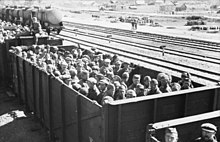
Polish forced labourers and Soviet prisoners of war were transported in similar poor conditions, also resulting in many deaths.[28][26]
At times, the Germans did not have enough Jews to fill an entire train's worth of wagons,[29][better source needed] so the victims were kept locked inside overnight at layover yards. The Holocaust trains also waited for military trains to pass.[27] An average transport took about four days. The longest transport of the war, from Corfu, took 18 days. When the train arrived at the camp and the doors were opened, everyone was already dead.[29][better source needed]
The SS built three extermination camps in occupied Poland specifically for Operation Reinhard: Bełżec, Sobibór, and Treblinka. They were fitted with identical mass-killing installations disguised as communal shower rooms.[30] In addition, gas chambers were developed in 1942 at the Majdanek concentration camp,[30] and at Auschwitz II-Birkenau.[30][31] In the German-occupied USSR, at the Maly Trostenets extermination camp, shootings were used to kill victims in the woods.[32] At Chełmno, victims were killed in gas vans, whose redirected exhaust fed into sealed compartments at the rear of the vehicle. These were used at Maly Trostenets as well.[33] Neither of these two camps had international rail connections; therefore, the trains stopped at the nearby Łódź Ghetto and Minsk Ghetto, respectively.[34] From there, the prisoners were taken by trucks.[34][35] At Treblinka, Belzec, and Sobibor, the killing mechanism consisted of a large internal-combustion engine delivering exhaust fumes to gas chambers through pipes.[36] At Auschwitz and Majdanek, the gas chambers relied on Zyklon B pellets of hydrogen cyanide, poured through vents in the roof from cans sealed hermetically.[36][37]
Once off the transports, the prisoners were split by category. The old, the young, the sick, and the infirm were sometimes separated for immediate death by shooting, while the rest were prepared for the gas chambers. In a single 14-hour workday, 12,000 to 15,000[38][page needed] people would be killed at any one of these camps.[36][39] The capacity of the crematoria at Birkenau was 20,000 bodies per day.[37][40]
-
Jews from Carpatho-Ruthenia are "selected" on the Judenrampe, May–June 1944. To be sent to the right meant assignment to slave labour; to the left, the gas chambers.[41]
The calculations
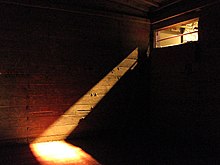
The standard means of transport was a 10-metre long (32 ft 9+3⁄4 in) freight car, although third class passenger carriages were also used when the SS wanted to keep up the "resettlement to work in the East" myth, particularly in the Netherlands and in Belgium. The SS manual covered such trains, suggesting a carrying capacity per trainset of 2,500 people in 50 cars, each boxcar loaded with 50 prisoners. In reality, however, boxcars were routinely loaded to 200% of capacity or 100 people per car.[42] This resulted in an average of 5,000 people per trainset. During the mass deportation of Jews from the Warsaw Ghetto to Treblinka in 1942, trains carried up to 7,000 victims each.[43]
In total, over 1,600 trains were organised by the Reich Ministry of Transport, and logged mainly by the Polish state railway company taken over by Germany, due to the majority of death camps being located in occupied Poland.[44] Between 1941 and December 1944, the official date of the closing of the Auschwitz-Birkenau complex, the transport/arrival timetable was 1.5 trains per day: 50 freight cars × 50 prisoners per freight car × 1,066 days = ~4,000,000 prisoners in total.[18]
On 20 January 1943, Heinrich Himmler sent a letter to Albert Ganzenmüller, the Under-secretary of State at the Reich Transport Ministry, requesting: "need your help and support. If I am to wind things up quickly, I must have more trains."[45] Of the estimated six million Jews exterminated during World War II, two million were murdered on the spot by the military, Waffen-SS, Order Police battalions and mobile death squads of the Einsatzgruppen aided by and the local auxiliary police. The remainder were shipped to their deaths elsewhere.[citation needed]
Payment
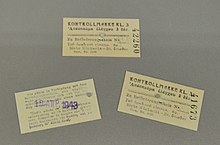
Most Jews were forced to pay for their own deportations, particularly wherever passenger carriages were used. This payment came in the form of direct money deposit to the SS in light of the "resettlement to work in the East" myth. Charged in the ghettos for accommodation, adult Jews paid full price one-way tickets, while children under 10–12 years of age paid half price, and those under four went free. Jews who had run out of money were the first to be deported.[1]
The SS forwarded part of this money to the German Transport Authority to pay the German Railways for transport of the Jews. The Reichsbahn was paid the equivalent of a third class railway ticket for every prisoner transported to his or her destination: 8,000,000 passengers, 4 Pfennig per track kilometer, times 600 km (average voyage length), equaled 240 million Reichsmarks.[24]
The Reichsbahn pocketed both this money and its own share of the cash paid by the transported Jews after the SS fees. According to an expert report established on behalf of the German "Train of Commemoration" project, the receipts taken in by the state-owned Deutsche Reichsbahn for mass deportations in the period between 1938 and 1945 reached a sum of US$664,525,820.34.[46]
Operations across Europe
Powered mainly by efficient steam locomotives, the Holocaust trains were kept to a maximum of 55 freight cars on average, loaded from 150% to 200% capacity.[18] The participation of German State Railway (the Deutsche Reichsbahn) was crucial to the effective implementation of the "Final Solution of the Jewish Question". The DRB was paid to transport Jews and other victims of the Holocaust from thousands of towns and cities throughout Europe to meet their death in the Nazi concentration camp system.[18]
As well as transporting German Jews, DRB was responsible for coordinating transports on the rail networks of occupied territories and Germany's allies. The characteristics of organized concentration and transportation of victims of the Holocaust varied by country.
Belgium
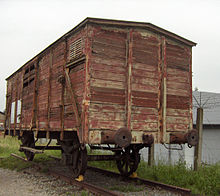
After Germany invaded Belgium on 10 May 1940, all Jews were forced to register with the police as of 28 October 1940. The lists enabled Belgium to become the first country in occupied Western Europe to deport recently immigrating Jews.[48] The implementation of the "Final Solution" in Belgium centred on the Mechelen transit camp (Malines) chosen because it was the hub of the Belgian National Railway system.[48] The first convoy left Mechelen for extermination camps on 22 July 1942, although nearly 2,250 Jews had already been deported as forced laborers for Organisation Todt to Northern France.[49] By October 1942, some 16,600 people had been deported in 17 convoys. At this time, deportations were temporarily halted until January 1943.[50][51] Those deported in the first wave were not Belgian citizens, resulting from the intervention by Queen Elisabeth with the German authorities.[50] In 1943, the deportations of Belgians resumed.
In September, Jews with Belgian citizenship were deported for the first time.[50] After the war, the collaborator Felix Lauterborn stated in his trial that 80 percent of arrests in Antwerp used information from paid informants.[52] In total, 6,000 Jews were deported in 1943, with another 2,700 in 1944. Transports were halted by the deteriorating situation in occupied Belgium before the liberation.[53]
The percentages of Jews who were deported varied by location. It was highest in Antwerp, with 67 percent deported, but lower in Brussels (37 percent), Liége (35 percent) and Charleroi (42 percent).[54] The main destination for the convoys was Auschwitz concentration camp in occupied Poland. Smaller numbers were sent to Buchenwald and Ravensbrück concentration camps, as well as Vittel concentration camp in France.[53] In total, 25,437 Jews were deported from Belgium.[53] Only 1,207 of these survived the war.[55]
The only time during World War II that a Holocaust train carrying Jewish deportees from Western Europe was stopped by the underground happened on 19 April 1943, when the Transport No. 20 left Mechelen with 1,631 Jews, heading for Auschwitz. Soon after leaving Mechelen, the driver stopped the train after seeing an emergency red light, set by the Belgians. After a brief firefight between the Nazi train guards and the three resistance members – equipped only with one pistol between them – the train started again. Of the 233 people who attempted to escape, 26 were shot on the spot, 89 were recaptured, and 118 got away.[56][57]
Bulgaria

Bulgaria joined the Axis powers in March 1941 and took part in the invasion of Yugoslavia and Greece.[58] The Bulgarian government set up transit camps in Skopje, Blagoevgrad and Dupnitsa for the Jews from the former Serbian province of Vardar Banovina and Thrace (today's North Macedonia and Greece).[58] The "deportations to the east" of 13,000 inmates,[59] mostly to Treblinka extermination camp began on 22 February 1943, predominantly in passenger cars.[60] In four days, some 20 trainsets departed under severely overcrowded conditions to occupied Poland requiring each train to stop daily to dump the bodies of Jews who died during the previous 24 hours.[45] In May 1943, the Bulgarian government led by King Boris III expelled 20,000 Jews from Sofia and at the same time, made plans to deport Bulgaria's Jews to the camps pursuant to an agreement with Germany.[60] A Holocaust train from Thrace was witnessed by Stefan I, the Metropolitan Bishop of Sofia, who was shocked by what he saw.[61] Ultimately, the Jews of Bulgaria proper were not deported.[61]
Bohemia and Moravia
Czechoslovakia was annexed by Nazi Germany in 1939. Within the new ethnic-Czech Protectorate of Bohemia and Moravia the Czechoslovak State Railways (ČSD) were taken over by the Reichsbann and the new German railway company Böhmisch-Mährische Bahn (BMB) was set up in its place.[62] Three-quarters of Bohemian and Moravian Jews were murdered in the Holocaust,[63] of whom 33,000 died in Theresienstadt Ghetto.[64] The remainder were transported in Holocaust trains from Theresienstadt mainly to Auschwitz-Birkenau. The last train for Birkenau left Theresienstadt on 28 October 1944 with 2,038 Jews of whom 1,589 were immediately gassed.[65]
France

The French national SNCF railway company under the Vichy Government was involved in the "Final Solution". In total, the Vichy government deported more than 76,000 Jews,[66] without food or water (pleaded for by the Red Cross in vain),[66] as well as thousands of other so-called undesirables to German-built concentration and extermination camps aboard the Holocaust trains, pursuant to an agreement with the German government; fewer than 3 percent survived the deportations.[67][68] According to Serge Klarsfeld, president of the organization Sons and Daughters of Jewish Deportees from France, SNCF was forced by German and Vichy authorities to cooperate in providing transport for French Jews to the border and did not make any profit from this transport.[69] However, in December 2014, SNCF agreed to pay up to $60 million worth of compensation to Holocaust survivors in the United States.[70] It corresponds to approximately $100,000 per survivor.[71]
Drancy internment camp served as the main transport hub for the Paris area and regions west and south thereof until August 1944, under the command of Alois Brunner from Austria.[72] By 3 February 1944, 67 trains had left from there for Birkenau.[65] Vittel internment camp served the northeast, closer to the German border from where all transports were taken over by German agents. By 23 June 1943, 50,000 Jews had been deported from France, a pace that the Germans deemed too slow.[73] The last train from France left Drancy on 31 July 1944 with over 300 children.[65]
Greece

After the invasion, Greece was divided between the Italian, Bulgarian, and German zones of occupation until September 1943. Most Greek Jews lived in Thessaloniki (Salonika) ruled by Germany, where the collection camp was set up for the Jews also from Athens and the Greek Islands. From there 45,000–50,000 Jews were sent to Auschwitz-Birkenau between March and August 1943, packed 80 to a wagon. There were also 13,000 Greek Jews in the Italian, and 4,000 Jews in the Bulgarian zone of occupation. In September 1943, the Italian zone was taken over by the Third Reich.
Overall, some 60,000–65,000 Greek Jews were deported in Holocaust trains by the SS to Auschwitz, Majdanek, Dachau and the subcamps of Mauthausen before the war's end,[74][75] including over 90% of Thessaloniki's prewar population of 50,000 Jews. Of these, 5,000 Jews were deported to Treblinka from the regions of Thrace and from Macedonia in the Bulgarian share of the partitioned Greece, where they were gassed upon arrival.[75][76]
Hungary
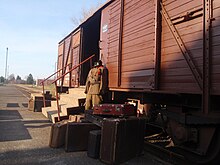
Under Hungarian control, the number of Jews officially increased to 725,007 by 1941. Of this total, 184,453 Jews lived in Budapest.[77] While in alliance with Nazi Germany, Hungary acquired new provinces at both the First and the Second Vienna Awards (1938; 1940). The Hungarian Army received vital help from the Hungarian State Railways (MÁV) in Northern Transylvania (Erdély).[78] The non-native Jews were expelled from the Hungarian territory; some 20,000 were transported to occupied Czechoslovakia and Yugoslavia, while the Transylvanian Jews were sent back to Romania.[79] Hungary took part in Operation Barbarossa, supplying 50,000 Jewish slave labour for the Eastern Front. Most of the workers were dead by January 1943. Later that year, Hitler discovered that Prime Minister Miklos Kállay secretly conferred with the Western Allies. To stop him, Germany launched the Operation Margarethe in March 1944, and took over control of all Jewish affairs.[77] On 29 April 1944, the first deportation of Hungarian Jews to Birkenau took place.[65] Between 15 and 25 May according to SS-Brigadeführer Edmund Veesenmayer 138,870 Jews had been deported. On 31 May 1944, Veesenmayer reported an additional 60,000 Jews were sent to the camps in six days, while the total for the past 16 days stood at 204,312 victims.[65] Between May and July 1944, helped by Hungarian police, the German Sicherheitspolizei deported nearly 440,000 Hungarian Jews, mainly to Auschwitz-Birkenau,[80][81] or 437,000 at the rate of 6,250 per day.[65]
Approximately 320,000 Hungarian Jews are estimated to have been murdered at Auschwitz-Birkenau before July 1944.[82] On 8 July, the deportation of Jews from Hungary had stopped due to international pressure by the Pope, the King of Sweden, and the Red Cross (all of whom had recently learned about the extent of it).[65] However, in October 1944 some 50,000 Jews were forced on a death march to Germany following a coup d'état which put the Hungarian pro-Nazi government back in control. They were forced to dig anti-tank ditches on the road westward. A further 25,000 Jews were put in an "international ghetto" under Swedish protection engineered by Carl Lutz and Raoul Wallenberg. When the Soviet Army liberated Budapest on 17 January 1945, of the original 825,000 Jews in the country,[83] less than 260,000 Jews were still alive,[83][84] including 80,000 Hungarian natives.[85][86]
Italy
The popular view that Benito Mussolini resisted the deportation of Italian Jews to Germany is widely seen as simplistic by Jewish scholars,[87] because the Italian Jewish community of 47,000 constituted the most assimilated Jews in Europe.[88] About one out of every three Jewish males were members of the Fascist Party before the war began; more than 10,000 Jews who used to conceal their identity,[88] because antisemitism was part of the very ideal of italianità, wrote Wiley Feinstein.[89]
The Holocaust came to Italy in September 1943 after the German takeover of the country due to its total capitulation at Cassibile.[89] By February 1944, the Germans shipped 8,000 Jews to Auschwitz-Birkenau via Austria and Switzerland,[90] although more than half of the victims arrested and deported from northern Italy were rounded up by the Italian police and not by the Nazis.[87] Also between September 1943 and April 1944, at least 23,000 Italian soldiers were deported to work as slaves in the German war industry, while over 10,000 partisans were captured and deported during the same period to Birkenau. By 1944, there were over half a million Italians working for the benefit of the German war machine.[91]
Netherlands
The Netherlands was invaded on 10 May 1940 and fell under German military control. The community of native-Dutch Jews including the new Jewish refugees from Germany and Austria was estimated at 140,000.[92] Most natives were concentrated in the Amsterdam ghetto before being moved to Westerbork transit camp in the north-east near the German border. Deportees for "resettlement" leaving aboard the NS passenger and freight trains were unaware of their final destination or fate,[93] as postcards were often thrown from moving trains.[94]
Most of the approximately 100,000 Jews sent to Westerbork perished.[94] Between July 1942 and September 1944 almost every Tuesday a train left for Auschwitz-Birkenau and Sobibor extermination camps, or Bergen-Belsen and Theresienstadt, in 94 outgoing trains. About 60,000 prisoners were sent to Auschwitz and 34,000 to Sobibor.[74][95] At liberation approximately 870 Jews remained in Westerbork. Only 5,200 deportees survived, most of them in Theresienstadt, approximately 1980 survivors, or Bergen-Belsen, approximately 2050 survivors. From those on the sixty-eight transports to Auschwitz 1052 people returned, including 181 of the 3450 people taken from eighteen of the trains at Cosel. There were 18 survivors out of approximately one thousand people selected from the nineteen trains to Sobibor, the remainder being murdered on arrival. For the Netherlands, the overall survival rate among Jews who boarded the trains for all camps was 4.86 percent.[96][97] On 29 September 2005, the Dutch national rail company Nederlandse Spoorwegen (NS) apologised for its role in the deportation of Jews to the death camps.[98]
Norway
Norway surrendered to Nazi Germany on 10 June 1940. At the time, there were 1,700 Jews living in Norway. About half of them escaped to neutral Sweden. Round-ups by the SS began in the fall of 1942 with the support of the Norwegian police. In late November 1942, all Jews of Oslo including women and children were put on a ship requisitioned by the Quisling government and taken to Hamburg, Germany. From there, they were deported to Auschwitz-Birkenau by train. In total, 770 Norwegian Jews were sent by boat to Germany between 1940 and 1945. Only two dozen survived.[99]
Poland
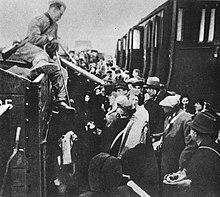
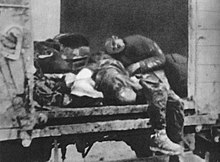
Following invasion of Poland in September 1939 Nazi Germany disbanded the Polish National Railways (PKP) immediately, and handed over their assets to the Deutsche Reichsbahn in Silesia, Greater Poland and in Pomerania.[100] In November 1939, as soon as the semi-colonial General Government was set up in occupied central Poland, a separate branch of DRB called Generaldirektion der Ostbahn (Kolej Wschodnia in Polish) was established with headquarters called GEDOB in Kraków;[100] all of the DRB branches existed outside Germany proper.[101] The Ostbahn was granted 3,818 kilometres (2,372 mi) of railway lines (nearly doubled by 1941) and 505 km of narrow gauge, initially.[102]
In December 1939, on the request of Hans Frank in Berlin, the Ostbahndirektion was given financial independence after paying back 10 million Reichsmarks to DRB.[103] The removal of all bomb damage was completed in 1940.[104] The Polish management was either executed in mass shooting actions (see: the 1939 Intelligenzaktion and the 1940 German AB-Aktion in Poland) or imprisoned at the Nazi concentration camps.[102] Managerial jobs were staffed with German officials in a wave of some 8,000 instant promotions.[100] The new Eastern Division of DRB acquired 7,192 kilometres (4,469 mi) of new railway lines and 1,052 km of (mostly industrial) narrow gauge in the annexed areas.[102]
The Deutsche Reichsbahn acquired new infrastructure in Poland worth in excess of 8,278,600,000 złoty,[105] including some of the largest locomotive factories in Europe, the H. Cegielski – Poznań renamed DWM, and Fablok in Chrzanów renamed Oberschlesische Lokomotivwerke Krenau producing engines Ty37 and Pt31 (designed in Poland), as well as the locomotive parts factory Babcock-Zieleniewski in Sosnowiec renamed Ferrum AG (tasked with making parts to V-1 i V-2 rockets also).[106] Under the new management, formerly Polish companies began producing German engines BR44, BR50 and BR86 as early as 1940 virtually for free, using forced labor. All Polish railwaymen were ordered to return to their place of work, or face death. Beating with fists became commonplace, although perceived as shocking by Polish long-term professionals. Their public executions were introduced in 1942.[102] By 1944, the factories in Poznań and Chrzanów were mass-producing for the Eastern Front the redesigned "Kriegslok" BR52 locomotives stripped of non-ferrous metals and instead made mostly of steel; locomotives in that battlespace were not expected to survive for long, so managers eliminated the use of higher-value metal like bronze, chrome, copper, brass, and nickel.[100]
Before the onset of Operation Reinhard which marked the most deadly phase of the Holocaust in Poland many Jews were transported by road to killing sites such as the Chełmno extermination camp, equipped with gas vans. In 1942, stationary gas chambers were built at Treblinka, Belzec, Sobibor, Majdanek and Auschwitz. After the Nazi takeover of PKP, the train movements, originating inside and outside occupied Poland and terminating at death camps, were tracked by Dehomag using IBM-supplied card-reading machines and traditional waybills produced by the Reichsbahn.[44] The Holocaust trains were always managed and directed by native German SS men posted with that express' role throughout the system.[107]
The transports to camps under Operation Reinhard came mainly from the ghettos. The Warsaw Ghetto in the General Government held eventually over 450,000 Jews cramped in an area meant for about 60,000 people. The second-largest Ghetto in Łódź held 204,000 Jews. Both ghettos had collection points known as Umschlagplatz along the rail tracks, with most deportations from Warsaw to Treblinka taking place between 22 July and 12 September 1942.[108][109][110] The gassing at Treblinka started on 23 July 1942, with two pendulum trains delivering victims six days each week ranging from about 4,000 to 7,000 victims per transport, the first in the early morning and the second in the mid-afternoon.[111] All new arrivals were sent immediately to the undressing area by the Sonderkommando squad that managed the arrival platform, and from there to the gas chambers. According to German records, including the official report by SS Brigadeführer Jürgen Stroop, some 265,000 Jews were transported in freight trains from the Warsaw Ghetto to Treblinka during this period. The murder operation code-named Grossaktion Warsaw concluded several months before the subsequent Warsaw Ghetto Uprising resulting in new deportations.[112] The 1942 Höfle Telegram of the total number of victims most of whom were transported by train to Operation Reinhard death camps, including cumulative numbers known today, is as follows:
|
 |
The Höfle Telegram lists the number of arrivals to the Reinhard camps through 1942 as 1,274,166 Jews based on Reichsbahn own records. The last train to be sent to Treblinka extermination camp left Białystok Ghetto on 18 August 1943; all prisoners were murdered in gas chambers after which the camp closed down per Globocnik's directive.[73] Of the more than 245,000 Jews who passed through the Łódź Ghetto,[117] the last 68,000 inmates, by then the largest final gathering of Jews in all of German-occupied Europe, had been murdered by the Nazis after 7 August 1944. They were told to prepare for resettlement; instead, over the next 23 days they were sent to Auschwitz-Birkenau by train at the rate of 2,500 per day.[65]
Romania
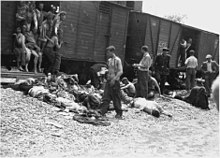
Căile Ferate Române (Romanian Railways) were involved in the transport of Jewish and Romani people to concentration camps in Romanian Old Kingdom, Bessarabia, northern Bukovina, and Transnistria.[118] In a notable example, after the Iasi pogrom events, Jews were forcibly loaded onto freight cars with planks hammered in place over the windows and traveled for seven days in unimaginable conditions.[118] Many died and were gravely affected by lack of air, blistering heat, lack of water, food or medical attention. These veritable death trains arrived to their destinations Podu Iloaiei and Călăraşi with only one-fifth of their passengers alive.[118][119][120] No official apology was released yet by Căile Ferate Române for their role in the Holocaust in Romania.
Slovakia
On 9 September 1941, the parliament of the Slovak State ratified the Jewish Codex, a series of laws and regulations that stripped Slovakia's 89,000 Jews of their civil rights and means of economic survival. The ruling Slovak People’s Party paid 500 Reichsmarks per expelled Jew, in exchange for a promise that the deportees would never return to Slovakia. Except for Croatia, Slovakia was the only Axis ally to pay for the deportation of its own Jewish population. Most of the Jewish population perished in two waves of deportations. The first, in 1942, took away two-thirds of the Slovak Jews; the second wave after the Slovak National Uprising in 1944 claimed another 13,500 victims, 10,000 of whom did not return.[121][122][123]
Switzerland
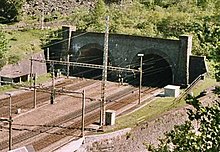
Switzerland was not invaded because its mountain bridges and tunnels between Germany and Italy were too vital for them to go into war,[124] while the Swiss banks provided necessary access to international markets by dealing in pilfered gold.[125] Most war supplies to Italy were shipped through the Austrian Brenner Pass.[126]
There exists substantial evidence that these shipments included Italian forced labour workers and trainloads of Jews in 1944 during the German occupation of northern Italy,[127] when a German train passed through Switzerland every 10 minutes. The need for the tunnel was complicated by the British Royal Air Force having bombed and disrupted services through the Brenner Pass, as well as a heavy snowfall in the winter of 1944–45.[91] Of 43 trains that could be tracked down by the 1996 Bergier Commission, 39 went via Austria (Brenner, Tarvisio), one via France (Ventimiglia-Nice). The commission could not find any evidence that the other three passed through Switzerland. It is possible that the train could have been carrying dissidents back from concentration camps. Started in 1944, some repatriation trains went through Switzerland officially, organised by the Red Cross.[124][128]
Aftermath
After the Soviet Army began to advance into German-occupied Europe and the Allies landed in Normandy in June 1944, the number of trains and transported persons began to vary greatly. By November 1944, with the closure of Birkenau, the death trains had ceased.[citation needed] As the Soviet and Allied armies made their final pushes, the Nazis transported some of the concentration camp survivors either to other camps located inside the collapsing Third Reich, or to the border areas where they believed they could negotiate the release of captured German prisoners of war in return for the "Exchange Jews" or those that were born outside the German-occupied territories. Many of the inmates were transported via the infamous death marches, but among other transports, three trains left Bergen-Belsen in April 1945 bound for Theresienstadt—all were liberated.[97]
The last recorded train is the one used to transport the women of the Flossenbürg March, where for three days in March 1945 the remaining survivors were crammed into cattle cars to await further transport. Only 200 of the original 1000 women survived the entire trip to Bergen-Belsen.[129]
Remembrance and commemoration
There are numerous national commemorations of the mass transportation of Jews in the "Final Solution" across Europe, as well as some lingering controversies surrounding the history of the railway systems utilized by the Nazis.
France
In 1992, SNCF commissioned a report on its involvement in World War II. The company opened its archives to an independent historian, Christian Bachelier, whose report was released in French in 2000.[130][131] It was translated to English in 2010.[132]
In 2001, a lawsuit was filed against French government-owned rail company SNCF by Georges Lipietz, a Holocaust survivor, who was transported by SNCF to the Drancy internment camp in 1944.[133] Lipietz was held at the internment camp for several months before the camp was liberated.[134] After Lipietz's death the lawsuit was pursued by his family and in 2006 an administrative court in Toulouse ruled in favor of the Lipietz family. SNCF was ordered to pay 61,000 Euros in restitution. SNCF appealed the ruling at an administrative appeals court in Bordeaux, where in March 2007 the original ruling was overturned.[133][135] According to historian Michael Marrus, the court in Bordeaux "declared the railway company had acted under the authority of the Vichy government and the German occupation" and as such could not be held independently liable.[130] [note 1] Marrus wrote in his 2011 essay that the company has nevertheless taken responsibility for its actions and it is the company's willingness to open up its archives revealing involvement in the transportation of Holocaust victims that has led to the recent legal and legislative attention.[130]
Between 2002 and 2004 the SNCF helped fund an exhibit on the deportation of Jewish children that was organized by Nazi hunter Serge Klarsfeld.[130] In 2011, SNCF helped set up a railway station outside of Paris to a Shoah Foundation for the creation of a memorial to honor Holocaust victims.[131] In December 2014, the company came to a $60 million compensation settlement with French Holocaust survivors living in the United States.[70]
Germany
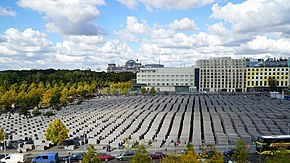
In 2004/2005, German historians and journalists began publicly demanding that the German passenger train stations' commemorative exhibits be set up after the railroad companies in France and the Netherlands began commemorations of mass deportations in their own train stations.[142] The Deutsche Bahn AG (DB AG), the state-owned successor of the Deutsche Reichsbahn replied: "we do not have either the personnel or the financial resources" for that kind of commemoration.[143] Demonstrations then began at railway stations in Frankfurt am Main and in Cologne as well as inside the long-distance border-crossing trains.[144] Because the DB AG had responded by having its security personnel repress the protests, German citizens' initiatives rented a historical steam locomotive and installed their own exhibition in remodeled passenger cars. This "Train of Commemoration" made its first journey on the 2007 International Holocaust Remembrance Day of January 27. The Deutsche Bahn AG refused it access to the main stations in Hamburg and Berlin.[145][146] German Jewish communities protested against the company levying mileage tariffs and hourly fees for the exhibit (which by December 31, 2013, reached approx. US $290,000).[147]
Parliamentarians of all parties in the German national parliament called on the DB AG to rethink its behavior.[148] Federal Transport Minister Wolfgang Tiefensee proposed an exhibition by artist Jan Philipp Reemtsma on the railways' role in the deportation of 11,000 Jewish children to their deaths in Nazi concentration and extermination camps throughout World War II. Because the CEO of the railroad company maintained his refusal, a "serious rift" occurred between himself and the Minister of Transport.[149] On January 23, 2008, a compromise was reached, wherein the DB AG established its own stationary exhibit Sonderzüge in den Tod [Chartered Trains to Death – Deportation with the German Reichsbahn].[150] As national press journals pointed out, the exhibit "contained nearly nothing about the culprits". The post-war careers of those in charge of the railroad remained "totally obscured".[151] Since 2009, the civil society association Train of Commemoration which, with its donations financed the exhibition "Train of Commemoration" presented at 130 German stations with 445,000 visitors, has been demanding cumulative compensation for the survivors of these deportations by train. The railroad's proprietors (the German Minister of Transport and the German Minister of Finances) rejected this demand.[152]
Netherlands
Nederlandse Spoorwegen used its 29 September 2005 apology for its role in the "Final Solution" to launch an equal opportunities and anti-discrimination policy, in part to be monitored by the Dutch Jewish council.[153]
Poland
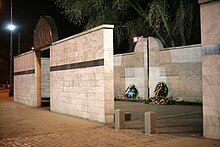
All railway lines leading to death camps built in occupied Poland are ceremonially cut off from the existing railway system in the country, similar to the well-preserved arrival point at Auschwitz known as the "Judenrampe" platform. The commemorative monuments are traditionally erected at collection points elsewhere. In 1988, a national monument was created at the Umschlagplatz of the Warsaw Ghetto. Designed by architect Hanna Szmalenberg and sculptor Władysław Klamerus, it consists of a stone structure symbolizing an open freight car.[154] In Kraków, the memorial to Jews from the Kraków Ghetto deported during the Holocaust spreads over the entire deportation site known as the Square of the Ghetto Heroes (Plac Bohaterow Getta). Inaugurated in December 2005, it consists of oversized steel chairs (each representing 1,000 victims), designed by architects Piotr Lewicki and Kazimierz Latak.[155] At the former Łódź Ghetto, the monument was built at the Radegast train station (Bahnhof Radegast), where approximately 200,000 Polish, Austrian, German, Luxemburg and Czech Jews boarded the trains on the way to their deaths in the period from 16 January 1942, to 29 August 1944.[156][157]
See also
Railway companies involved
- Deutsche Reichsbahn, the German Reich Railway
- CFR, the state railways of Romania
- MÁV, Hungarian State Railways
- BDZ (БДЖ), Bulgarian national Railways
- National Railway Company of Belgium, National Railway Company of Belgium
- Nederlandse Spoorwegen (NS) in the Netherlands[153]
- Ostbahn, a railway operator set up by the General Government in occupied Poland[158]
- SNCF, French National Railway Company
Memorials
Footnotes
- ^ Following the Lipietz trial, SNCF's involvement in World War II became the subject of attention in the United States when SNCF explored bids on rail projects in Florida and California, and SNCF's partly owned subsidiary, Keolis Rail Services America bid on projects in Virginia and Maryland.[132] In 2010, Keolis placed a bid on a contract to operate the Brunswick and Camden lines of the MARC train in Maryland.[132] Following pressure from Holocaust survivors in Maryland, the state passed legislation in 2011 requiring companies bidding on the project to disclose their involvement in the Holocaust.[136][137] Keolis currently operates the Virginia Railway Express, a contract the company received in 2010.[132][136] In California, also in 2010, state lawmakers passed the Holocaust Survivor Responsibility Act. The bill, written to require companies to disclose their involvement in World War II,[138] was later vetoed by Governor Arnold Schwarzenegger.[137][139] While bidding on these rail contracts, SNCF was criticized for not formally acknowledging and apologizing for its involvement in World War II. In 2011, SNCF chairman Guillaume Pepy released a formal statement of regrets for the company's actions during World War II.[131][140][141] Some historians have expressed the opinion that SNCF has been unfairly targeted in the United States for their involvement in World War II. Human rights attorney Arno Klarsfeld has argued that the negative focus on SNCF was disrespectful to the French railway workers who lost their lives engaging in acts of resistance.[131]
Citations
- ^ a b Prof. Ronald J. Berger, University of Wisconsin–Whitewater (2002). Fathoming the Holocaust: A Social Problems Approach. Transaction Publishers. pp. 57–58. ISBN 978-0202366111.
Bureaucrats in the Reichsbahn performed important functions that facilitated the movement of trains. They constructed and published timetables, collected fares, and allocated cars and locomotives. In sending Jews to their death, they did not deviate much from the routine procedures they used to process ordinary train traffic.
- ^ Simone Gigliotti (2009). The Train Journey: Transit, Captivity, and Witnessing in the Holocaust. Berghahn Books. pp. 36, 55. ISBN 978-1845459277.
- ^ HOLOCAUST FAQ: Operation Reinhard: A Layman's Guide (2/2).
- ^ Tomasz Wiścicki (16 April 2013), Train station to hell. Treblinka death camp retold by Franciszek Ząbecki [Stacja tuż obok piekła. Treblinka w relacji Franciszka Ząbeckiego], Muzeum Historii Polski [Museum of Polish History], archived from the original on October 6, 2013, retrieved 2 February 2016 – via Internet Archive,
Wspomnienia dawne i nowe by Franciszek Ząbecki (en), Pax publishing, Warsaw 1977.
; also in Clancy Young (2013), Treblinka Death Camp Day-by-Day. Tables with record of daily deportations, Holocaust Education & Archive Research Team, archived from the original on May 22, 2013, retrieved 2 February 2016 – via Internet Archive,Timeline of Treblinka (en).
- ^ Yad Vashem (2014), Nazi Germany and the Jews 1933-1939, archived from the original on 2014-02-07
- ^ Herf, Jeffrey (2006). The Jewish Enemy: Nazi Propaganda during the World War II and the Holocaust. Harvard University Press. p. 122. ISBN 978-0-674038-59-2.
- ^ Andrew Rawson (2015). Auschwitz: The Nazi Solution. Pen and Sword. p. 29. ISBN 978-1473855410.
- ^ Claude Lanzmann Shoah Collection (July 1978). Henryk Gawkowski and Treblinka railway workers (Camera Rolls #4-7) (in Polish and French). USHMM, Washington, DC: Steven Spielberg Film and Video Archive. Event occurs at 02:10:59 and 07:10:16. ID: 3362-3372. Retrieved 8 September 2015 – via Clips viewable online.
- ^ Types of Ghettos. United States Holocaust Memorial Museum, Washington, D.C.
- ^ a b Raul Hilberg (1998). "German Railroads / Jewish Souls". The Role of the German Railroads in the Destruction of the Jews. 35 (2): 162–174. doi:10.1007/BF02838139. S2CID 144274402.
- ^ "1939: The War Against The Jews." The Holocaust Chronicle published by Publications International, April 2000.
- ^ Michael Berenbaum, The World Must Know, United States Holocaust Memorial Museum, 2006, p. 114.
- ^ a b Peter Vogelsang & Brian B. M. Larsen, "The Ghettos of Poland." Archived 2013-10-22 at the Wayback Machine The Danish Center for Holocaust and Genocide Studies. 2002.
- ^ Marek Edelman. "The Ghetto Fights". The Warsaw Ghetto: The 45th Anniversary of the Uprising. Literature of the Holocaust, at the University of Pennsylvania.
- ^ François Furet, Unanswered Questions: Nazi Germany and the Genocide of the Jews. Schocken Books (1989), p. 182; ISBN 0-8052-4051-9.
- ^ "'Final Solution': Overview". Holocaust Encyclopedia. United States Holocaust Memorial Museum. Archived from the original on 2 March 2013.
- ^ The Holocaust Chronicle. "Reichsbahn". Death and Resistance. Publications International. p. 415. Retrieved 6 February 2014.
- ^ a b c d Hedi Enghelberg (2013). The trains of the Holocaust. Kindle Edition. p. 63. ISBN 978-160585-123-5.
- ^ Rossino, Alexander B. (2003-11-01). ""Polish 'Neighbours' and German Invaders: Anti-Jewish Violence in the Białystok District during the Opening Weeks of Operation Barbarossa."". In Steinlauf, Michael C.; Polonsky, Antony (eds.). Polin: Studies in Polish Jewry Volume 16: Focusing on Jewish Popular Culture and Its Afterlife. The Littman Library of Jewish Civilization. pp. 431–452. doi:10.2307/j.ctv1rmk6w.30. ISBN 978-1-909821-67-5. JSTOR j.ctv1rmk6w.
- ^ Jewish Virtual Library (2009). "Gas Chambers at Majdanek". Majdanek, Auschwitz II, Sobibor, Belzec and Treblinka. The American-Israeli Cooperative. Retrieved 11 February 2014.
- ^ German Railways and the Holocaust at the United States Holocaust Memorial Museum.
- ^ Cesarani, David (2005). Eichmann: His Life and Crimes. Vintage. p. 120. ISBN 978-0-09-944844-0.
- ^ "The Holocaust". Concentration Camps & Death Camps. Raiha Evelyn. Archived from the original on July 23, 2009. Retrieved 4 February 2014.
- ^ a b c Richard L. Rubenstein; John K. Roth (2003). Approaches to Auschwitz. Westminster John Knox Press. p. 362. ISBN 9780664223533 – via Google Books, search inside.
- ^ Michael Nadel, Recalling the Holocaust
- ^ a b Gerlach, Christian (2016). The Extermination of the European Jews. Cambridge University Press. p. 287. ISBN 9780521880787.
- ^ a b Joshua Brandt (April 22, 2005). "Holocaust survivor gives teens the straight story". Jewish news weekly of Northern California. Archived from the original on November 26, 2005. Retrieved 5 February 2014.
- ^ Gerlach, Christian (2016). The Extermination of the European Jews. Cambridge University Press. p. 233. ISBN 9780521880787.
- ^ a b Ben Hecht, Julian Messner (December 31, 1969), Holocaust: The Trains. Archived February 22, 2014, at the Wayback Machine Aish.com Holocaust Studies.
- ^ a b c Yad Vashem (2013). "Aktion Reinhard" (PDF). Shoah Resource Center, The International School for Holocaust Studies. Retrieved 6 April 2014 – via direct download 33.1 KB.
- ^ Grossman, Vasily (1946). "The Treblinka Hell" (PDF). Moscow: Foreign Languages Publishing House. (online). Archived from the original (PDF) on 6 October 2014. Retrieved 6 April 2014 – via direct download 2.14 MB.
- ^ Yad Vashem (2013). "Maly Trostinets" (PDF). Shoah Resource Center, The International School for Holocaust Studies. Retrieved 1 September 2013 – via direct download, 19.5 KB.
- ^ "The genocide: 1942 (Chelmno, Maly Trostinets)". Peace Pledge Union. Archived from the original on 2 December 2014. Retrieved 6 April 2014.
- ^ a b "Maly Trostinec". ARC 2005. Retrieved 6 April 2014.
Maly Trostinec most closely resembled Chelmno, although at Maly Trostinec, murder was principally committed by shooting.
- ^ Chris Webb; Carmelo Liscioto. "Maly Trostinets. The Death Camp near Minsk". Holocaust Research Project.org 2008. Retrieved 6 April 2014.
Jews were killed by means of mobile gas chambers... and shot to death in front of pits, 50 meters long and 3 metres deep.
- ^ a b c Arad, Yitzhak (1987). Belzec, Sobibor, Treblinka. The Operation Reinhard Death Camps. Bloomington, Indianapolis: Indiana University Press. p. 31. ISBN 978-0-253-21305-1 – via Google Books, preview.
Testimony of SS Scharführer Erich Fuchs in the Sobibor-Bolender trial, Düsseldorf.
- ^ a b Piper, Franciszek (1994). "Gas Chambers and Crematoria". In Gutman, Yisrael; Berenbaum, Michael (eds.). Anatomy of the Auschwitz Death Camp. Bloomington, Indiana: Indiana University Press. pp. 169–170. ISBN 978-0-253-32684-3.
- ^ Alex Woolf (2008). A Short History of the World. Arcturus. ISBN 978-1848588721.
- ^ McVay, Kenneth (1984). "The Construction of the Treblinka Extermination Camp". Yad Vashem Studies, XVI. Jewish Virtual Library.org. Retrieved 3 November 2013.
- ^ Friedlander, Saul (2009). The Years of Extermination. New York: HarperCollins. ISBN 978-0-06-198000-8.
- ^ "The Auschwitz Album". Yad Vashem. Retrieved 4 February 2014.
- ^ Geoffrey P. Megargee (2009). The United States Holocaust Memorial Museum Encyclopedia of Camps and Ghettos, 1933–1945. Indiana University Press. p. 1514. ISBN 978-0253003508. Retrieved 4 February 2014.
- ^ "Treblinka: Railway Transports". This Month in Holocaust History. Yad Vashem. Archived from the original on 8 October 2014. Retrieved 4 February 2014.
- ^ a b Edwin Black on IBM and the Holocaust
- ^ a b NAAF Project. "The Holocaust timeline: 1943". NeverAgain.org, Internet Archive. Archived from the original on August 22, 2006. Retrieved 5 February 2014.
- ^ Train of Commemoration (November 2009). Expert Report on the Deutsche Reichsbahn's Receipts (PDF) (in German, English, French, and Polish). Train of Commemoration Registered, Non-Profit Association, Berlin. Archived from the original (PDF) on 2014-02-22. Retrieved 4 February 2014 – via direct download 740 KB from Wayback Machine.
With payment summaries, tables and literature.
{{cite book}}:|work=ignored (help) - ^ Schreiber, Marion (2003). The Twentieth Train: The True Story of the Ambush of the Death Train to Auschwitz (1st US ed.). New York: Grove Press. p. 203. ISBN 978-0-8021-1766-3.
- ^ a b "The Destruction of the Jews of Belgium". Holocaust Education & Archive Research Team. Retrieved 28 February 2014.
Native-born Belgian Jews were first noticed at Auschwitz after 744 of them were received at the camp following deportation of 998 Jews from Mechelen on 5 August 1942.
- ^ Yahil, Leni (1991). The Holocaust: The Fate of European Jewry, 1932–1945. Studies in Jewish History (Reprint (trans.) ed.). Oxford: Oxford University Press. p. 393. ISBN 978-0-19-504523-9.
- ^ a b c Yahil, Leni (1991). The Holocaust: The Fate of European Jewry, 1932–1945. Studies in Jewish History (Reprint (trans.) ed.). Oxford: Oxford University Press. p. 435. ISBN 978-0-19-504523-9.
- ^ Yahil, Leni (1991). The Holocaust: The Fate of European Jewry, 1932–1945. Studies in Jewish History (Reprint (trans.) ed.). Oxford: Oxford University Press. p. 394. ISBN 978-0-19-504523-9.
- ^ Saerens, Lieven (2008). De Jodenjagers van de Vlaamse SS. Lannoo. p. 188. ISBN 978-90-209-7384-6.
- ^ a b c Yahil, Leni (1991). The Holocaust: The Fate of European Jewry, 1932–1945. Studies in Jewish History (Reprint (trans.) ed.). Oxford: Oxford University Press. p. 436. ISBN 978-0-19-504523-9.
- ^ Saerens, Lieven (1998). "Antwerp's Attitudes towards the Jews from 1918–1940 and its Implications for the Period of Occupation". In Michman, Dan (ed.). Belgium and the Holocaust: Jews, Belgians, Germans (2nd ed.). Jerusalem: Yad Vashem. p. 194. ISBN 978-965-308-068-3.
- ^ Waterfield, Bruno (17 May 2011). "Nazi hunters call on Belgium's justice minister to be sacked". The Telegraph. Archived from the original on December 6, 2013. Retrieved 26 February 2013.
- ^ a b Althea Williams; Sarah Ehrlich (20 April 2013). "Escaping the train to Auschwitz". BBC News. Retrieved 20 April 2013.
Policeman John Aerts who helped the runaways evade recapture and return to Brussels was later declared a "Righteous Gentile" by Yad Vashem in Jerusalem. Of the three resistance workers: Robert Maistriau was arrested in March 1944, liberated from Bergen-Belsen in 1945, and lived until 2008; Youra Livschitz was later captured and executed; Jean Franklemon was arrested and sent to Sachsenhausen, liberated from there in May 1945, and died in 1977.
- ^ When the Twentieth convoy arrived at Auschwitz, 70% of the women and girls were gassed immediately upon arrival. Sources claim that all of the remaining women from Belgian Transport No.20 were sent to Block X of Birkenau for medical experimentation.[56]
- ^ a b Persecution of Jews in Bulgaria United States Holocaust Memorial Museum, Washington, DC.
- ^ PRWEB (28 February 2011). "International Jewish Committee Calls on Bulgaria to Clarify Their Role in the Deportation of 13,000 Jews to Treblinka". Vocus PRWeb. Archived from the original on March 6, 2011. Retrieved 23 June 2015.
- ^ a b "Treblinka: Chronology". Holocaust Encyclopedia. United States Holocaust Memorial Museum. 10 June 2013. Archived from the original on 5 June 2012. Retrieved 9 December 2013 – via Wayback Machine.
Deportations from Bulgarian-occupied territory among others.
- ^ a b Rossen V. Vassilev, The Rescue of Bulgaria's Jews in World War II New Politics, Winter 2010, Vol: XII-4.
- ^ OKm11 at Locomotives.com.pl.
- ^ Hugh LeCaine Agnew (2004). The Czechs and the Lands of the Bohemian Crown. Hoover Press. pp. 215, 1942. ISBN 978-0817944926.
- ^ "The Holocaust Chronicle", Roots of the Holocaust, Prologue: p. 282, Publications International, 2009, retrieved 16 February 2014
- ^ a b c d e f g h NAAF Holocaust Project Timeline: 1944. NAAF Holocaust Project.
- ^ a b Committee on the Judiciary (20 June 2012). "Holocaust-Era Claims in the 21st Century, Hearing" (PDF). One Hundred Twelfth Congress, Second Session. United States Senate. p. 4 (8 / 196). Retrieved 6 February 2014 – via direct download 2.58 MB.
- ^ J.-L. Einaudi and Maurice Rajsfus, Les silences de la police—16 July 1942 and 17 October 1961, L'Esprit frappeur, 2001, ISBN 2-84405-173-1
- ^ Bremner, Charles (2008-11-01). "Vichy gets chance to lay ghost of Nazi past as France hosts summit". The Times. London. Retrieved 2008-11-01.[dead link]
- ^ Serge Klarsfeld (26 June 2012). "Analysis of Statements Made During the June 20, 2012 Hearing of the U.S. Senate Committee of the Judiciary" (PDF). Memorial de la Shoah. Archived from the original (PDF) on 2 December 2013. Retrieved 19 November 2013.
- ^ a b "France to compensate American survivors of Holocaust". The Washington Post. 2014-12-05. Archived from the original on 2021-05-18.
- ^ Le Monde, Pour le rôle de la SNCF dans la Shoah, Paris va verser 100 000 euros à chaque déporté américain [1]
- ^ Henley, Jon (2003-03-03). "French court strikes blow against fugitive Nazi". The Guardian. London. Archived from the original on October 12, 2007. Retrieved 2014-02-06.
France condemned Brunner to death in absentia in 1954 for crimes against humanity. He is still wanted.
- ^ a b NAAF Holocaust Project Timeline 1943 Continued. NeverAgain.org.
- ^ a b Deportations to Killing Centers
- ^ a b Steven Bowman (2002). "The Jews in Greece" (PDF). Minorities in Greece: Aspects of a Plural Society: 9 of current document (427). Archived from the original (PDF) on 1 July 2013. Retrieved 18 February 2014 – via direct download.
- ^ Peter Vogelsang; Brian B. M. Larsen (2002). "Deportations from the Balkans". Holocaust Education: Deportations. The Danish Center for Holocaust and Genocide Studies. Archived from the original on 16 April 2014. Retrieved 18 February 2014.
- ^ a b Naftali Kraus, Holocaust Period. Jewish History of Hungary.
- ^ Librarian (10 Sep 2006), Hungarian military in WWII. Archived 2021-05-19 at the Wayback Machine Bulletin, Senta, Serbia.
- ^ Naftali Kraus (2014). "Jewish History of Hungary". Porges.net. Retrieved 24 February 2014.
- ^ "Deportations to Killing Centers: Central Europe". Holocaust Encyclopedia. United States Holocaust Memorial Museum, Washington, DC. May 11, 2012. Archived from the original on August 16, 2012. Retrieved 24 February 2014.
- ^ Yad Vashem, Hungarian Jewry Archived 2013-10-21 at the Wayback Machine at Holocaust History.
- ^ Andrew Rawson (2015). Auschwitz: The Nazi Solution. Pen and Sword. pp. 69, 87, 123. ISBN 978-1473855410.
While the numbers considerably reduced through June and July [1944], nearly 440,000 Hungarian Jews were transported to Auschwitz in less than eight weeks; 320,000 were murdered.]
Also in: S.J.; Carmelo Lisciotto (2007). "The Destruction of the Jews of Hungary". H.E.A.R.T.Of the 381,600 Jews who left Hungary between 15 May 1944 and 30 June 1944 it is probable that 200,000 – 240,000 were gassed or shot on 46 working days.
- ^ a b Rebecca Weiner, Hungary Virtual Jewish History Tour Jewish Virtual Library.
- ^ David Kranzler, The Man Who Stopped the Trains to Auschwitz: George Mantello, El Salvador, and Switzerland's Finest Hour. [page needed]
- ^ Bridge, Adrian (1996-09-05). "Hungary's Jews Marvel at Their Golden Future". The Independent. London. Retrieved 2014-02-27.
- ^ Peter Vogelsang & Brian B. M. Larsen, Deportations. Archived 2014-04-16 at the Wayback Machine The Danish Center for Holocaust and Genocide Studies.
- ^ a b Bridget Kevane (June 29, 2011). "A Wall of Indifference: Italy's Shoah Memorial". The Forward. Retrieved 16 April 2014.
- ^ a b Egill Brownfeld (Fall 2003). "The Italian Holocaust: The Story of an Assimilated Jewish Community". Jewish Fascists and Anti-Fascists. The American Council For Judaism. Retrieved 16 April 2014.
- ^ a b Franklin Hugh Adler (Winter 2006). "The Civilization of the Holocaust in Italy: Poets, Artists, Saints, Anti-Semites by Wiley Feinstein". Book Review. 20 (3): 518–520. Retrieved 16 April 2014.
- ^ "Deportations to Killing Centers". Holocaust Encyclopedia. United States Holocaust Memorial Museum. June 10, 2013. Retrieved 16 April 2014.
- ^ a b Frontline, Switzerland: The Train. PBS.org
- ^ Jewish Virtual Library, Netherlands (Holland): The Holocaust Era. Encyclopedia Judaica.
- ^ Yad Vashem, Deportation train from Westerbork, Holland Archived 2014-03-05 at the Wayback Machine. Photo Archives 43253.
- ^ a b Van der Boom (1 May 2007), Holocaust in the Netherlands: 'We really had no idea'. Leiden University. Review of Tegen beter weten in by Ies Vuijsje's.
- ^ Holocaust Encyclopedia, Westerbork. [dead link] United States Holocaust Memorial Museum, Washington, D.C.
- ^ Schelvis, Jules (1993). Vernietigingskamp Sobibor (in Dutch) (5th. (2004) ed.). De Bataafsche Leeuw. pp. 236ff. ISBN 9789067076296.
- ^ a b BBC - Birmingham - Faith - The Last Train from Belsen
- ^ "Like a slow train coming". Expatica.com. Archived from the original on 2007-12-11.
- ^ Holocaust Encyclopedia. "Norway". United States Holocaust Memorial Museum. Roundups of Norwegian Jews. Retrieved 20 January 2016.
Photographs of two deportation ships: SS Donau and SS Monte Rosa, courtesy of Oskar Mendelsohn.
- ^ a b c d Jerzy Wasilewski (2014). "25 września. Wcielenie kolei polskich na Śląsku, w Wielkopolsce i na Pomorzu do niemieckich kolei państwowych Deutsche Reichsbahn" [25 September: Absorption of Polish railways to German Reichsbahn]. Polskie Koleje Państwowe PKP. Historia kolei na terenie Polski. Archived from the original on 8 February 2014. Retrieved 8 February 2014 – via Archive.is, page missing from Wayback.
- ^ Simone Gigliotti (2009). Resettlement. Berghahn Books. p. 55. ISBN 978-1845459277. Retrieved 21 September 2015.
{{cite book}}:|work=ignored (help) - ^ a b c d Masłowska, Teresa (2 September 2007). "Wojenne Drogi Polskich Kolejarzy" [On the war paths of Polish railwaymen] (PDF). Czy Wiesz, że...: 13. Archived from the original (PDF) on 24 February 2012. Retrieved 8 February 2014 – via PDF file, direct download (644 KB), archived by Wayback Machine. Magazine Kurier PKP was last published in 2010.
- ^ Alfred C. Mierzejewski (Jun 19, 2003). Most Valuable Asset of the Reich: A History of the German National Railway 1933-1945. Univ. of North Carolina Press. pp. 78–80. ISBN 9780807825747. Retrieved 9 February 2014.
{{cite book}}:|work=ignored (help) - ^ Hans Pottgiesser (1975) [1960]. Die Deutsche Reichsbahn im Ostfeldzug 1939 - 1944. Kurt Vowinkel Verlag. pp. 17–18.
- ^ Ireneusz Bujniewicz (2009). "Możliwości finansowe PKP w przebudowie i rozbudowie kolejnictwa" (PDF). Kolejnictwo w przygotowaniach obronnych Polski w latach 1935–1939. Wydawnictwo Tetragon Publishing. p. 22. Archived from the original (PDF) on 22 February 2014. Retrieved 8 February 2014 – via PDF file, direct download 363 KB.
- ^ Michał Kubara; Beata Mamcarczyk; Marcin Paździora; Sandra Schab (2012). Sosnowiec (PDF). Zagłębiowska Oficyna Wydawnicza Publishing. pp. 84–85. ISBN 978-83-928381-1-1. Archived from the original (PDF) on 6 December 2013. Retrieved 9 February 2014 – via direct download 9.97 MB.
{{cite book}}:|work=ignored (help) - ^ Edward Kopówka (2011), "Treblinka II (Monograph, chapt. 3)" (PDF), Dam im imię na wieki [I will give them an everlasting name. Isaiah 56:5] (in Polish), Drohiczyńskie Towarzystwo Naukowe [The Drohiczyn Scientific Society], p. 97, ISBN 978-83-7257-496-1, archived from the original (PDF) on 10 October 2014, retrieved 9 February 2014 – via direct download 20.2 MB
- ^ "Aktion Reinhard" (PDF). Yad Vashem Shoah Resource Center, The International School for Holocaust Studies.
See: 'Aktion Reinhard' named after Reinhard Heydrich, the main organizer of the "Final Solution"; also, Treblinka, 50 miles northeast of Warsaw, set up June/July 1942.
- ^ Robert Moses Shapiro (1999). Holocaust Chronicles. Published by KTAV Publishing Inc. 1999, 302 pages. ISBN 9780881256307. Retrieved 5 February 2014.
... the so-called Gross Aktion of July to September 1942... 300,000 Jews murdered by bullet of gas (page 35).
- ^ "Holocaust Remembrance Day in Warsaw". Archived from the original on 26 April 2009. Retrieved 5 February 2014.
- ^ Kopówka, Edward; Rytel-Andrianik, Paweł, "Treblinka II – Obóz zagłady (Treblinka II Death Camp)" (PDF), Monograph, chapt. 3: ibidem, Drohiczyńskie Towarzystwo Naukowe, p. 94, ISBN 978-83-7257-496-1, archived from the original (PDF) on 2014-10-10 – via Drohiczyn Scientific Society, direct download 20.2 MB.
- ^ Holocaust Encyclopedia (10 June 2013). "Warsaw Ghetto Uprising". US Holocaust Memorial Museum. Archived from the original on 2 May 2012. Retrieved 25 August 2013.
- ^ Jacek Małczyński (2009-01-19). "Drzewa "żywe pomniki" w Muzeum – Miejscu Pamięci w Bełżcu [Trees as living monuments at Bełżec]". Współczesna Przeszłość, 125-140, Poznań 2009: 39–46. Retrieved 8 August 2013.
- ^ Paweł Reszka (Dec 23, 2005). "Majdanek Victims Enumerated. Changes in the history textbooks?". Gazeta Wyborcza. Auschwitz-Birkenau State Museum. Archived from the original (Internet Archive) on November 6, 2011. Retrieved April 29, 2013.
- ^ Raul Hilberg (1985), The Destruction of the European Jews by Yale University Press, p. 1219. ISBN 978-0-300-09557-9, versus Thomas Blatt (1983), Sobibor - The Forgotten Revolt by H.E.P., pp. 3, 92; ISBN 0964944200
- ^ Holocaust Encyclopedia, "Treblinka" United States Holocaust Memorial Museum.
- ^ Jennifer Rosenberg (1998). "The Lódz Ghetto: History & Overview (1939 - 1945)". Jewish Virtual Library. Retrieved 8 February 2014.
- ^ a b c d "The Iasi Death Trains. Holocaust in Romania (Chapter 5)" (PDF), Report of the International Commission on the Holocaust in Romania, Bucharest: Yad Vashem, November 11, 2004, pp.20–22 of Ch.5, Final Report (consisting of 19 PDF files), retrieved 2017-09-29
- ^ Marcu Rozen (2006). "The Holocaust under the Antonescu government". Association of Romanian Jews Victims of the Holocaust (A.R.J.V.H.). Archived from the original on 2015-09-24. Retrieved 2014-02-27.
- ^ "Holocaust in Podu Iloaiei, Romania".
- ^ Rajcan, Vanda; Vadkerty, Madeline; Hlavinka, Ján (2018). "Slovakia". In Megargee, Geoffrey P.; White, Joseph R.; Hecker, Mel (eds.). Camps and Ghettos under European Regimes Aligned with Nazi Germany. Encyclopedia of Camps and Ghettos. Vol. 3. Bloomington: United States Holocaust Memorial Museum. pp. 842–852. ISBN 978-0-253-02373-5.
- ^ Nižňanský, Eduard (2011). "The discussions of Nazi Germany on the deportation of Jews in 1942 – the examples of Slovakia, Rumania and Hungary" (PDF). Historický časopis. 59 (Supplement): 121. ISSN 0018-2575.
- ^ Kamenec, Ivan (2007) [1991]. On the Trail of Tragedy: The Holocaust in Slovakia. Translated by Styan, Martin. Bratislava: Hajko & Hajková. p. 337. ISBN 978-80-88700-68-5.
- ^ a b Markus G. Jud, Switzerland's Role in World War II at History of Switzerland.
- ^ Markus G. Jud, Looted Assets, Gold Transactions and Dormant Accounts at Switzerland during World War II.
- ^ The Avalon Project: The Versailles Treaty June 28, 1919 Archived February 8, 2007, at the Wayback Machine at www.Yale.edu
- ^ Marks, David. "The Train | Switzerland". Frontline. PBS. Retrieved 17 December 2019.
- ^ Independent Commission of Experts, Switzerland—World War II. Bergier Commission for the Swiss Government
- ^ NAAF Holocaust Project Timeline: 1945. Never Again.org.
- ^ a b c d Marrus, Michael R. (2011). "Chapter 12: The Case of the French Railways and the Deportation of Jews in 1944". In Bankier, David; Michman, Dan (eds.). Holocaust and Justice. Berghahn Books. ISBN 978-9-65308-353-0.
- ^ a b c d Baume, Maïa De La (25 January 2011). "French Railway Formally Apologizes to Holocaust Victims". The New York Times. Retrieved 26 October 2012.
- ^ a b c d Shaver, Katherine (7 July 2010). "Holocaust group faults VRE contract". The Washington Post. Retrieved 15 November 2012.
- ^ a b "French railways win WWII appeal". BBC. 27 March 2007. Retrieved 16 November 2012.
- ^ CBC News (7 June 2006). "French railway must pay for transporting family to Nazis". Retrieved 15 November 2012.
- ^ Canellas, Claude (27 March 2007). "Court quashes SNCF Nazi deportations ruling". Reuters. Archived from the original on March 5, 2016. Retrieved 15 November 2012.
- ^ a b Zeitvogel, Karin (20 May 2011). "US governor signs Holocaust disclosure law". European Jewish Press. Archived from the original on 14 April 2013. Retrieved 16 November 2012.
- ^ a b Witte, Brian (19 May 2011). "Md. governor signs bill on company's WWII role". Businessweek. Archived from the original on 12 March 2016. Retrieved 16 November 2012.
- ^ Samuel, Henry (30 August 2010). "SNCF to open war archives to California". The Telegraph. London. Archived from the original on 2022-01-12. Retrieved 16 November 2012.
- ^ Weikel, Dan (2 October 2010). "Schwarzenegger vetoes bill requiring rail firms interested in train project to disclose WWII-era activities". Los Angeles Times. Retrieved 16 November 2012.
- ^ Schofield, Hugh (13 November 2010). "SNCF apologises for role in WWII Jewish deportations". BBC News. Retrieved 15 November 2012.
- ^ Ganley, Elaine (14 November 2010). "SNCF, French Railroad, Apologizes For Holocaust Role Before Florida Bid". The Huffington Post. Retrieved 16 November 2012.
- ^ "Die Niederländische Bahn und die Judendeportatiopnen" [The Dutch Railways and the deportation of Jews]. Der Centraal Joods Overleg, Amsterdam. Neue Zürcher Zeitung. 19 October 2005. Retrieved 4 February 2014.
- ^ Letter from the Deutsche Bahn AG, 17 December 2004
- ^ TV 3 sat: Kulturzeit, 10 July 2005
- ^ "Holocaust Deportation Exhibit Denied Access to Berlin Central". Deutsche Welle. 8 April 2008. Retrieved 4 February 2014.
Following story: "Remembrance train banned from station". The Guardian, 11 April 2008.
- ^ Catherine Hickley (April 8, 2008). "Deutsche Bahn 'Embarrasses' Berlin by Hampering Holocaust Show". Bloomberg, Berlin.
- ^ "Row over Traveling Exhibition: Holocaust Survivors' Group Slams German Rail", Spiegel Online, SPIEGEL-Online, 10 March 2008
- ^ Zug der Erinnerung, Verkehrsausschuss Deutscher Bundestag, 15 January 2008. (in German)
- ^ Spiegel No. 43, 23 October 2006.
- ^ DW staff (2008-01-24). "Nazi Death Train Exhibit Opens in Berlin Station". Deutsche Welle. Archived from the original on 5 April 2008. Retrieved 5 February 2014.
- ^ Katharina Schuler (24 January 2008), "Sonderzüge in den Tod", Die Zeit (in German), ZEIT-Online, retrieved 7 February 2014
- ^ Zug der Erinnerung The Train of Memory homepage. (in German)
- ^ a b Dutch news - Expatica Archived 2007-12-11 at the Wayback Machine
- ^ Sybille Steinbacher, Auschwitz: A History, trans. by Shaun Whiteside, Penguin Books. ISBN 0-14-102142-X.
- ^ "The Krakow Ghetto". JewishKrakow.net. Archived from the original on 24 July 2011. Retrieved 7 February 2014.
- ^ "Memorial Radegast station". Centrum Dialogu im. Marka Edelmana w Łodzi. 2013. Archived from the original on 3 December 2013. Retrieved 7 February 2014.
- ^ Lucjan Dobroszycki (1984). The Chronicle of the Lodz Ghetto, 1941-1944. Yale University Press. pp. 514–515. ISBN 978-0300039245.
- ^ Gigliotti, Simone (2009). The Train Journey: Transit, Captivity, and Witnessing in the Holocaust. Berghahn Books. ISBN 978-0-85745-427-0.
References
- Dawidowicz, Lucy S. (1986). The War Against the Jews, 1933–1945. New York: Free Press. ISBN 978-0-02-908030-6.
- Hilberg, Raul (2003). The Destruction of the European Jews. New Haven, Conn.: Yale University Press. ISBN 978-0-300-09557-9.
- Kranzler, David (2000). The Man Who Stopped the Trains to Auschwitz: George Mantello, El Salvador, and Switzerland's Finest Hour. Syracuse, N.Y.: Syracuse University Press. ISBN 978-0-8156-2873-6. Winner of the 1998 Egit Prize (Histadrut) for the Best Manuscript on the Holocaust.
- Gurdus, Luba Krugman (1978). The Death Train: A Personal Account of a Holocaust Survivor. New York: National Council on Art in Jewish Life. ISBN 978-0-89604-005-2.
- Hedi Enghelberg (1997). "The Trains of the Holocaust". Enghelberg.com, revised.
External links
- Transports to Extinction: The Deportation of the Jews during the Holocaust: The Central Theme for Holocaust Remembrance Day 2022, on the Yad Vashem website
- Transports to Extinction: The Holocaust Deportation Database on the Yad Vashem website
- Video of deportation, unknown location in Poland by SS and Polish Blue Police.

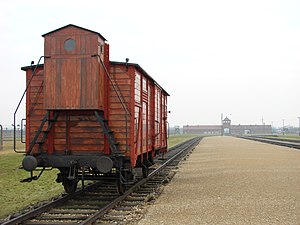
![Jews from Carpatho-Ruthenia are "selected" on the Judenrampe, May–June 1944. To be sent to the right meant assignment to slave labour; to the left, the gas chambers.[41]](http://up.wiki.x.io/wikipedia/commons/thumb/1/13/Selection_on_the_ramp_at_Auschwitz-Birkenau%2C_1944_%28Auschwitz_Album%29_1b.jpg/336px-Selection_on_the_ramp_at_Auschwitz-Birkenau%2C_1944_%28Auschwitz_Album%29_1b.jpg)

